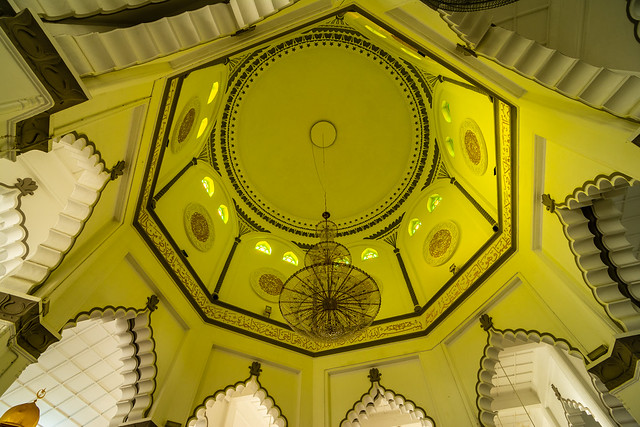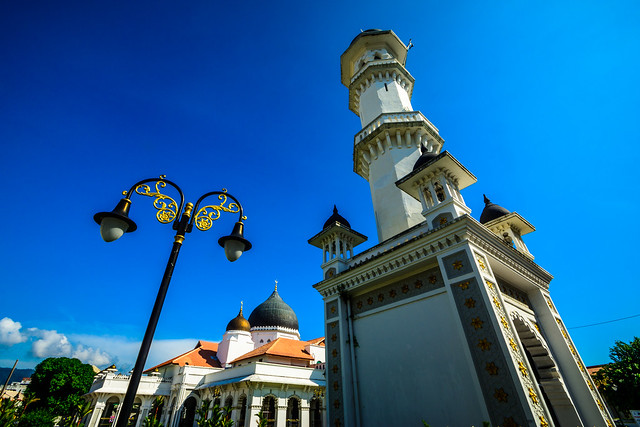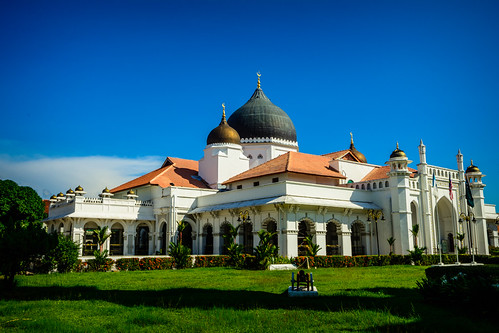The Kapitan Keling Mosque | The Penang's oldest mosque steeped in more than 200 years of history
 |
| The Kapitan Keling Mosque |
The Kapitan Keling Mosque (Masjid Kapitan Keling in Malay) is arguably the oldest mosque in Penang. This prominent place of worship for muslims is strategically located at the corner of Lebuh Buckingham and a road that bears its name, Jalan Masjid Kapitan Keling (formerly Pitt Street), well within Core Zone of George Town UNESCO World Heritage Site. The mosque, despite being steeped in history dating back to the late 18th century, originated from humble beginnings.
According to David S Jones, the first mosque on the current site of the Kapitan Keling Mosque dates prior to the 1798 map of George Town that indicates a small building marked "Chulier Mosque" which was the predecessor of the present Kapitan Keling Mosque. A British East Indian Company (BEIC) sepoy, Major Nador Kain, popularly known as Tok Nadok Berkajang Kain, is attributed by oral tradition as the founder of the mosque. The mosque then was just a humble structure made of timber and roofed over with attap. It was erected to cater to the BEIC troops as well as the growing number of the Chulias (Tamil Muslims).
After Captain Francis Light successfully concluded an agreement with Sultan of Kedah, Light and his entourage arrived in Penang Island on 17 August 1786 and officially took control of the island on behalf of the BEIC. Among the earliest people who migrated and settled in George Town, Penang in large group were the Chulias. According to a renowned researcher on Penang history, Khoo Salma Nasution, the word Chulia or Chulier, was coined by the BEIC for Tamil Muslims from the Chola Kingdom of India. Their lands (Cholamandalam) in South India were collectively called the Coromandel Coast by the Europeans.
On Jan 25, 1794, Light wrote that the Chulias who hailed from the ports along the Coromandel Coast as well as from nearby Kedah were second only to the Chinese in terms of numbers. While most of them were shopkeepers, other members of this community earned their keep by working as traders, boatmen and labourers.
In 1801 judging by the significant population of Indian Muslim immigrants around Chulia Street, Lieutenant Governor of Penang, Sir George Leith, appointed Cauder Mohuddeen Marican as the leader among them who carried the title Kapitan Keling. The word kapitan stemmed from the corrupted word of captain while Keling was referred to Chulia or Chulier (Indian Muslims) who hailed from Coromandel Coast (The ancient name of that place was Kalinga), South India. Hence the term Kapitan Keling (The Captain of Kelings).
Cauder Mohuddeen Marican, a Maraikkaya, was a wealthy ship mandor (foreman) who traded with Nagore, Nagapattinam and Kedah. He came from Porto Novo - the Tamils call it Paringgipettai while the Muslims call it Mahmudbandar, on the coast of South Arcot, 32 miles south of Pondicherry.
In that same year Leith granted a piece of land for the Kapitan Keling Mosque. Leith on behalf of the British East India Company (BEIC) granted to the "Mohammedan Church" a piece of ground on the south side of Malabar Street (now Chulia Street). The property was estimated to contain 5,468 square jumbas, or about 18 acres. In this grant the land is described as being bounded towards the West and South by grounds belonging to Cauder Mohuddeen.
The grant clearly stated that the land could not be sold or transferred otherwise its ownership would immediately revert to the BEIC once it ceased to be used for the religious purpose intended.
Over a period of two years, Cauder Mohuddeen demonstrated capable leadership by bringing in builders, stones and bricks from South India to build the mosque. He turned to Tamil Nadu when seeking architectural inspirations for what was to become the original version of the present Kapitan Keling Mosque. Cauder Mohuddeen had the artisans embellish the building with intricate details like miniature stepped minarets, oil lamp niches, heavy stucco mouldings, lattices and fine dentilation.
In 1803, a rectangular building with pyramidal roof complete with a circular well on the southern section and main entrance along Lebuh Chulia was ready to receive its first congregation. The picture below is the earliest known photograph of Kapitan Keling Mosque taken between 1863 and 1869. It is believed that is what the original structure of the Kapitan Keling Mosque looks like.
The mosque was then named after the Kapitan Keling to honour Cauder Mohuddeen for his initiatives, monetary contribution and great leadership in making the construction of the mosque a success. He was regarded as the founder of the mosque.
RESTORATION AND RENOVATION
The Kapitan Keling Mosque went through several stages of development to cater to the ever growing congregation as well as to strengthen the structure.
In 1910, the Kapitan Keling Mosque was skillfully extended, with some parts of the original mosque walls retained within the larger building; the original minarets can still be identified. The spectacular new look of the mosque could be described as Mughal revival or Indo-Saracenic, with a fancy roof of domes and turrets, and the walls elaborately stuccoed and coloured to simulate the Mughal monuments of India, which employed different coloured stone and marble. The work was commissioned by the Mohamedan and Hindu Endowments Board. The architect was a Malacca-born Eurasian of Germnan decent, Henry Alfred Neubronner.
The building of the minaret in 1916 marked the completion of this phase of expansion. The minaret has a slab with the inscription that reads 'This Minaret was erected by the Endowments Board from the funds of the Capitan Kling Mosque. W.Peel President, H.C Sells Secretary. The foundation stone was laid by Haji Abdullah Imam. Committee of Management, Shaik Ismail, Haji Yahya Khatib. N.A. Neubronner F.R.I.B.A. Architect. 13th Rabi-al-Akhir A.M. 1334. 18th February 1916."
The shophouses immediately adjacent to the south of the minaret were cleared soon afterwards so that the mosque could be fully viewed from Pitt Street (now Jalan Masjid Kapitan Keling). As a result the mosque and its minaret became the most prominent landmark in the neighbourhood
Khoo Salam Nasution stated as follows on the extension and additions done to the mosque:
"The original mosque was a single storey building with minarets at each corner, with an outer colonnade and a low scalloped wall and granite are similar that found in the Acheh Street Mosque. It was enlarged at the turn of the century into a grand and elaborate structure with minarets, turrets and domes. In 1916, its first major renovation carried out with an extension of the mosque, the addition of the Mughal domes and turrets, a large minaret for the muezzin and a ‘madrasah’ (school) for religious classes. The present form was achieved after yet another extension and re-roofing exercise, probably in 1930's. The wall around the mosque was built at the same time. Minarets and alcove of the original mosque can still be seen at the back of the present mosque. The first extensions survive as an ornate inner wall on the outer aisle."
 |
| The current Kapitan Keling Mosque with its prominent minaret |
The secondary domes of the main building at the west remain preserved. The onion shaped domes,
pointed multifoil arches, and chattries are the peculiar characteristics of Mughal architecture. The
mosque also has adornments with the Neo-Classical architectural elements of the colonial style, and it
is a blend of both colonial and Mughal style.
The renovation completed in 1930 gave the Kapitan Keling Mosque its present appearance. Besides doubling the height of the central prayer hall by C. Bouther, improvement to the ventilation system was also carried out to allow more natural light to enter. The exterior was ochre yellowed (then) while the interior had white marble floors and a high ceiling. The interior aisles are formed by a series of horseshoe arches, crowned with King Edward's plaques. The façade of the building and its interior were decorated with geometric designs, as human and animal forms are forbidden in Islam.
 |
| Inside the present day Kapitan Keling Mosque |
 |
| Underneath the central dome |
 |
| The "mimbar" on which the imam stands when delivering the sermon or "khutbah" |
The Kapitan Keling Mosque again underwent its refurbishment in 2003, with a RM5 million grant, as water seepage and poor drainage had affected the building, closing it down for a year. In this renovation, some alterations that did not compromise the original aesthetics of the building were included. Among the new extensions were a covered walkway and a women's ablution area. Calligraphy was added to the interior of the main dome and walls, where once these were decorated with feral motifs. An Islamic Information Centre is also set up on the ground floor of the minaret.
GEORGE TOWN UNESCO WORLD HERITAGE SITE
On 7 July 2008, Melaka and George Town were awarded with the joint inscription as the Historic Cities of the Straits of Malacca as a UNESCO World Heritage Site. The inscription was based on the Outstanding Universal Value (OUV) of cultural diversity embodied and embedded in living heritage and built heritage. The OUV is a set of ideas or values, universally recognised as important or as having influenced the evolution of mankind as a whole at one time or another.
According to George Town World Heritage Inc. website the buildings (built heritage) within the George Town UNESCO World Heritage Site are categorised into four categories encompassing both conservation and compatible development. The Kapitan Keling Mosque which is located in Core Zone of George Town UNESCO World Heritage Site falls under Category 1 of conservation. It states that for buildings categorised as conservation Category 1, buildings and sites should remain as originally intended, or be of similar use or nature of activity. Repairs carried out should use authentic, traditional ways of building methods and materials.
 |
| The prominent minaret (in the foreground) was added during the expansion of the mosque in 1916 designed by Neubronner. |
 |
| The column surmounted with small dome is retained from the original structure completed in 1803 (See picture of the original structure below) |
 |
| The original structure of the Kapitan Keling Mosque. (Image is reproduced from wongchunwai.com published without permission but in accordance with the principle of fair use) |
 |
| The wrought iron gate |
 |
| The Kapitan Keling Mosque |
 |
| The Kapitan Keling Mosque and the trishaw - two iconic identities of Penang |
[Updated on 6 August 2020]
REFERENCES
Ahmad Sanusi Hassan, & Asif Ali. (2019, August 9). Colonial influence on Indian Muslim religious monuments in Penang. International Transaction Journal of Engineering, Management, & Applied Sciences & Technologies. Retrieved from http://tuengr.com/V10A/10A13D.pdf
Cheah, A. (2018, June 12). The Kapitan Keling - a mosque rich in history [Blog post]. Retrieved from https://www.adriancheah.com/index.php?option=com_content&view=article&id=187:the-kapitan-keling-a-mosque-rich-in-history&catid=34&Itemid=115
Jones, D.S. (1997, November). Masjid Kapitan Keling : conservation project in Penang, Architecture + Design, vol. 14, no. 6, November-December, pp. 40-43.
Khoo, S.N. (1997, October 30). The urban legacy of Penang’s early settlers. Historical background of the cultural heritage area. Retrieved from http://www.hbp.usm.my/sanusi/lalilu/websitewarisan/tentative%20lists/urban%20legacy/urban%20legacy.htm
Muslim heritage in George Town. (2013). George Town World Heritage Inc. Retrieved from http://gtwhi.com.my/wp-content/uploads/2019/05/Muslim-Heritage-in-George-Town-English-FINAL_Web.pdf
Sundaraj, A. (2016, March 21). The Chulias of Penang. New Straits Times. Retrieved from https://www.nst.com.my
Teh, L.S. (2018, May 20). Unusual beginnings of Penang's oldest mosque. New Straits Times. Retrieved from http://www.nst.com.my
The origin of Chulia in Penang. (2017, April 10). Persatuan Alumni UITM Malaysia. Retrieved from http://www.alumniuitm.org.my
Wong, C.W. (n.d.). The Star’s humble beginnings were in Pitt Street and so were the writer’s. Wong Chun Wai. Retrieved from http://wongchunwai.com/2013/03/the-stars-humble-beginnings-were-in-pitt-street-and-so-were-the-writers/


Comments
Post a Comment